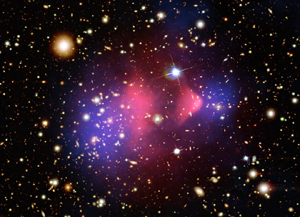There really is dark matter out there, says Dennis Zaritsky of the University of Arizona talking of the first evidence for this elusive cosmological substance, Now we just need to figure out what it is.
It was side-on views of two merging galaxy clusters made with state-of-the-art optical and X-ray telescopes that allowed Zaritsky and his colleagues to make this startling discovery. Dark matter is matter that does not emit or reflect enough electromagnetic radiation to be observed directly. Astronomers have assumed since the 1930s that most of the Universe must be composed of dark matter because of the way galaxies move through space. Our present understanding of gravity implies that the Universe must contain five times as much dark matter as normal matter

Zaritsky and colleagues have found evidence of dark matter
Evidence for dark matter has not been forthcoming. However, our theories of cosmology and the ultimate fate of the Universe hinge on whether or not it is real or not. The only means astronomers have of testing whether dark matter exists is to infer it from the gravitational effects it has on the more familiar visible matter.
When galaxy clusters merge, the galaxies themselves are so sparsely scattered in space that they don’t collide, team leader Doug Clowe, now at Ohio University explains, Even if two galaxies do pass through each other, the distance between the stars is so great that even stars won’t collide. Galaxies basically plough through each other almost without slowing down.

The galactic bullet cluster formed as two large galactic clusters merged in the most energetic known event since the Big Bang (Credit: NASA)
Most of a galaxy cluster’s normal mass lies in its diffuse hot gas. Galaxy clusters typically contain ten times as much ordinary mass in gas as in stars. So when galaxy clusters merge, the hot gas from each cluster drags on the other, slowing all the gas down. This means that while the galaxies continue to speed through space much of the gas is left behind.
Observations made with NASA’s Chandra X-ray Observatory showed the bulk of ordinary matter is in the hot gas clouds left in the wake of the galaxies. Part of this million-degree plasma of hydrogen and helium, the part from the smaller cluster, forms a spectacular bullet-shaped cloud because a bow shock, or supersonic shock wave, is created in the collision.
When the astronomers mapped the region of the sky around the galaxies in optical light, they discovered far more mass near the galaxies, ahead of the gas cloud. They analyzed gravitational lensing of distant galaxies in images taken with NASA’s Hubble Space Telescope, the European Southern Observatory’s 2-metre Wide-Field Imager and one of the twin 6.5-metre Magellan telescopes that a consortium that includes UA operates in Chile. They discovered the mass of non-luminous, or dark, matter that causes the lensing is far greater than the mass of ordinary matter in the gas cloud.
Nature gave us this fantastic opportunity to see hypothesized dark matter separated from ordinary matter in this merging system, explains Clowe, Prior to this observation, all of our cosmological models were based on an assumption that we couldn’t prove: that gravity behaves the same way on the cosmic scale as on Earth.
Astronomers have been in the somewhat embarrassing position of saying that we understand the Universe, although more than 80 percent of it is something we don’t know anything about, adds Zaritsky. That has all changed thanks to this discovery.
Further reading
Astrophys J Lett, in press
http://arxiv.org/abs/astro-ph/0608407
Dennis Zaritsky
http://ngala.as.arizona.edu/dennis/
Chandra X-ray Observatory
http://www.nasa.gov/mission_pages/chandra/main/
Suggested searches
dark matter